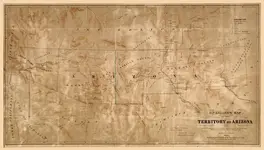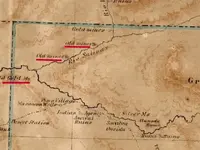cw0909
Silver Member
Nothing more than Pareidolia in my opinion
your prob right
Nothing more than Pareidolia in my opinion
Never really know I guess - maybe it was the ghost of Brownie Holmes as it sort of looks like himyour prob right

The quote was from the Emilio letter to Erwin Ruth , and goes like this :
My uncle said his father never wanted American to have the old mine but now he thinkgs (sic) your family deserve it if you can afford to work it praticly (sic).
My uncle beleive (sic) that much gold still therer and can be found if you could dig for enough to reach this old mine where they worked it years ago.
I believe it is Emilio who is referring to that mine as an "old mine," and not his uncle. Emilio would be right to call it an old mine in 1932.


Well......in support of Emilio AND his uncle referring to "the" mine as the old mine......Here's a copy of R. P. Kelley's 1860 map. This map was published in 1860 and taken from Kelley's notes compiled from earlier ventures. There certainly were "old mines" in the area. Nope, don't think this one is the LDM. After all, it wouldn't be lost if it was included on the map. But there were old mines existing before 1860. In my opinion, long before 1860. But that's just my thoughts.
View attachment 1467389View attachment 1467397
IMO , if one mine would be opened and worked by my family over few generation , I would call it just a " mine " , but if my family would find and work a mine , I would call it an " old mine " .
Matthew, thank you for a well written, thought provoking piece. It definitely opens new areas to ponder in the mystery of the death of Adolph Ruth.
I don’t have any answers or even much in the way of insight to add to the events surrounding his death.
As I am often want to do <g> I do have points of trivia to add to the mix. Not much to help you find a lost mine. But; perhaps I can help fill in some holes in seeing more of the totality of the man, Adolph Ruth.
Best sources available, Ancestry.com, family histories, the writings of James R. Kearney and such, it appears Adolph Ruth was born in Germany in about 1854, immigrated and was raised in New York. Some sources indicate he married first, Dalia, and his first child was a son, Charles. What became of these two individuals I do not know.
In 1881 he married second, Clara Belling (sometimes referenced as Beiling) in upstate New York. Their daughter, Stella was born in 1882, a son Erwin was born in 1887, and a son Earl was born in 1896.
The family moved to Missouri in 1888 and spent a brief time farming there. Shortly they moved to Kansas City where Adolph worked as a barber and sold barber supplies.
I have been unable to independently verified this but according to the writer and historian, James R. Kearney, Ruth wanting to better his fortunes and attended Kansas City Veterinary College graduating as a DVM in 1903. Mr. Kearney’s work is well sourced so I have no reason to doubt his statement. I find it entirely reasonable in that Ruth was in the right place at the right time for this to happen. Ruth, in later documents was often referenced as Dr. Ruth.
It was during this time that (apparently) Ruth began to fudge his date and place of birth. It is thought this was to better his chances of being admitted to college as a younger man and of native birth.
After graduation Ruth took employment with the USDA in the newly established Animal Inspection dept. conducting and overseeing the intake, inspection, slaughter, and packing preparation of meat products in Kansas City.
Ruth was transferred (at his request) to Richmond, VA in 1917. The family rented a home at 3 S. Auburn Avenue in the Museum District, an upper middle class neighborhood of the time. It is located about 1 ¼ mile from what was then the Richmond Stockyards. I’m certain this was Ruth’s primary base of operation and reason for being stationed in the Richmond area.
It was from Richmond, VA that Adolph and Erwin Ruth made their 1919 trip to the Borrego area of California to look for the mine from the Gonzales’ maps. This is our first real glimpse into the impetuous and impulsive nature of Ruth the man in his later years. Ruth did not receive nor ask for time off from work. He did cajole his physician into writing a recommendation that he “rest” which he forwarded to his employer as they drove out of town. He didn’t wait for approval of that rest period, he just left, AWOL, in search of the Gonzales mine. It was in the canyons of this California desert area that he wondered off alone in late evening and fell into a crevice severely breaking his right thigh. A San Diego hospital performed the surgery to install a metal plate repairing his broken leg. He returned to work nearly 8 month later. It must have been just as hard to fire Federal workers then as it is now. <g>.
Ruth’s heart apparently was not into his work and it spiraled downhill from this time forward. The quality of his work suffered and complaints from his co-worker and supervisors abounded. He was transferred to Charles Town, WVA and in 1921 to Wheeling, WVA. In June of 1922 his pay was cut because he couldn’t satisfactorily perform his duties. He retired in July of 1924. Keep in mind he was a full 70 years of age at the time having “fudged” his date of birth on his employment records.
Post retirement he and Clara moved to Washington D.C. to be closer to their daughter Stella. The 1930 census shows him as head of household with Clara and Stella in residence on 37th Street.
It was from here that Ruth determined to make the fateful trip to Arizona. And the rest, is history.
George Lusk, anyone?
There doesn't seem to be much information on him or his nameless partner- certainly nothing posted in any of the forums.
I am starting to walk back my hypothesis on Purnell being the culprit. There are a few things that stand out to me. While experienced in a variety of trades, neither Purnell or Keenan were real prospectors, nor had either spent extensive time in the mountains. Consquently they wouldn't have been helpful in guiding Ruth or in understanding his maps.
Also, as dumb as they may have been, I don't think they would be so dumb as to take Ruth's car for a joyride after dispensing of him. Frontier justice was still the rule of the day back then, and that sort of incrimination would be more than good enough to warrant a "hanging" offense. This is not to say they weren't involved- I hypothesize that they purposely guided Ruth to Willow Springs where he was to "meet" with prospectors who would take him out into the mountains, knowing full well that Ruth probably wasn't coming back out.

There is one angle that hasn't been explored here and it's Glen Magill's theory that while Purnell and Keenan packed Ruth to Willow Springs, they didn't take him out in the mountains. Two prospectors did: George Lusk and his unnamed partner.
According to Curt Gentry (via Magill) it was those two who initially "acquired" the original maps from Ruth, and these reportedly ended up with Lusk's widow.
I have often wondered about the timeline as far as just exactly when Purnell and Keenan packed Ruth, and when they were seen joyriding in his auto.
